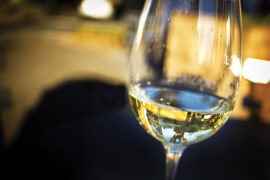By Matt DeBord
HQ 48 | SUMMER 2003
What is it about wine that puts a tremble in even the strongest of men? I mean, after all, it’s just a beverage. Nothing more than preserved fruit juice, nicely packaged. Still, it intimidates, threatens, bewilders even. This isn’t wine’s fault. It’s been around for centuries and will be around for centuries more.
There was a time, back before basic sanitation, when wine was actually considered to be preferable to water, as a basic refreshment. Because wine contained alcohol, it was far less likely to inflict upon its consumers a nasty parasitic infection.
No, people fear wine mainly for cultural reasons. Americans in particular, as our levels of wine consumption are far outpaced by the citizens of such venerable winechugging nations as Spain, Italy and, of course, France.
France. If you want to sum up the fear of wine in one world, France’II do it. Americans, until quite recently, have always been in the habit of accepting the propagandistic view of themselves that the French project: that is, as the undisputed masters of Western culture. Their hauteur in matters of art, literature and (ahem) warfare (Napoleon, you know) naturally extends to the realm of cuisine — where the French can legitimately claim to have produced something special — and oenophilly, which is a snooty term for “liking wine” and also something the French believe they do better than anybody else.
The truth is that France is the wellspring of many of the world’s great wine styles. Popular wines from California, Australia and South America are all based on French models. Cabernet Sauvignon? Made famous by the French region of Bordeaux. Ditto Merlot. Chardonnay? The great white grape of Burgundy. Syrah? An important grape in the Rhone (so synonymous with France that the Australians call it “Shiraz”). So if you plan to spend any time at all in life enjoying wine, you’re going to have to confront either your francophilia, or your francophobia, head on.
Francophilia is easier — you simply accept that you love and adore the French and happily go about drinking their wonderful wines. Francophobia is different, because if wine intimidates you, then French wine is going to intimidate you more than anything else.
Solution? Don’t drink French wine.
At least not right away. Consider yourself fortunate. As a living, breathing human being in the early 21st century, you have the luxury of avoiding French wine, in all its attendant complexity, without really cheating yourself out of a thoroughly magnificent wine-drinking life.
In fact, you don’t have much of an excuse for being afraid of wine, if you take France out of the picture. Here’s why: Over the past 20 years, the wine industry has become increasingly homogenized. Long ago — like, the 1950s — it was important to know where a wine came from. Regional difference lent different wines different qualities. Wine connoisseurs highly prized these regional differences, thereby inventing the contemporary idea of the wine snob, thereby giving rise to the fear of wine.
The along came California and Australia, along with South America — collectively known as the “New World”— and all those regional distinctions went out the window. These days, wine is a much simpler thing for the average consumer to understand. Bottles are typically labeled by grape variety (Chardonnay, Merlot, Pinot Noir) rather than by an arcane system that focuses on who made the wine, or where the grapes were grown. All you need to do is decide what you like and run with it.
Let’s say you’ve gotten on a Pinot Noir kick. You might not know that Pinot Noir is the only red grape variety that can go into the great wines of Burgundy in France. But it doesn’t make any difference, because you know what you like, and that’s the important thing.
What you need now is discipline. You are going to have to force yourself to drink Pinot Noir and nothing else for a month. It’s going to be total immersion. And when you come out, you are going to possess a relative mastery of Pinot Noir. One less wine to fear.
You are going to stumble across some lousy Pinot Noirs during the course of this little experiment. But you are also going to find some good ones. Early on, it makes sense to specialize in Pinots from California. Later, you may feel like taking the plunge and giving Burgundy a whirl. But the basic idea here is to vanquish the intimidation. Then you can get fancy.
Huntingtonians are fortunate in that a local restaurant, Savannah’s, has put a number of very good California Pinot Noirs on its Wine Spectator Award of Excellence-winning wine list which, by the way, is not an easy award to get — and I should know, as I was a judge when I worked there.
One of my favorites is from a producer called Saintsbury. Savannah’s has this wine in halfbottles, a nice format when you’re first sampling a new style of wine. It’s a fairly typical California Pinot, in that its flavor profile is generously fruity. This contrasts with French Burgundy, which tends to be higher in acidity, and, in off-vintages, a bit on the lean side.
But you don’t have to go out to eat to enhance your Pinot knowledge. At the retail level, there are also plenty of nice California Pinots to be had, some at extremely reasonable prices. Whether it’s at your local grocery store or wine specialty shops like the Corner Depot or La Fontaines, I recommend looking for the Pepperwood Grove label. Their Pinot is nothing special, but, at around $9, it’s an inexpensive introduction. From there, you can trade up to Robert Mondavi Coastal’s version, which showcases a higher level of winemaking complexity. After that, you’ll want to nail down the regions within California that produce your favorite Pinots. The Russian River Valley is considered by many Pinot Noir nuts to make the best.
Obviously, it doesn’t matter if you start with Pinot Noir. It could be Chardonnay. It could be Cabernet Sauvignon. The point is, pull some corks, or order some wine at restaurants. Figure wine into both your budget and your future image of yourself.
In time, you might even come around on the French.





